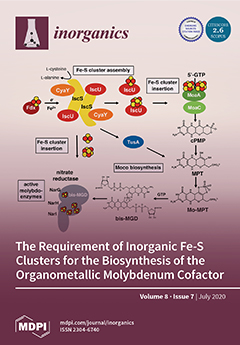Here, we report recent progress our laboratories have made in understanding the maturation and reaction mechanism of the cytosolic and NAD
+-dependent formate dehydrogenase from
Cupriavidus necator. Our recent work has established that the enzyme is fully capable of catalyzing the reverse
[...] Read more.
Here, we report recent progress our laboratories have made in understanding the maturation and reaction mechanism of the cytosolic and NAD
+-dependent formate dehydrogenase from
Cupriavidus necator. Our recent work has established that the enzyme is fully capable of catalyzing the reverse of the physiological reaction, namely, the reduction of CO
2 to formate using NADH as a source of reducing equivalents. The steady-state kinetic parameters in the forward and reverse directions are consistent with the expected Haldane relationship. The addition of an NADH-regenerating system consisting of glucose and glucose dehydrogenase increases the yield of formate approximately 10-fold. This work points to possible ways of optimizing the reverse of the enzyme’s physiological reaction with commercial potential as an effective means of CO
2 remediation. New insight into the maturation of the enzyme comes from the recently reported structure of the FdhD sulfurase. In
E. coli, FdhD transfers a catalytically essential sulfur to the maturing molybdenum cofactor prior to insertion into the apoenzyme of formate dehydrogenase FdhF, which has high sequence similarity to the molybdenum-containing domain of the
C. necator FdsA. The FdhD structure suggests that the molybdenum cofactor may first be transferred from the sulfurase to the C-terminal cap domain of apo formate dehydrogenase, rather than being transferred directly to the body of the apoenzyme. Closing of the cap domain over the body of the enzymes delivers the Mo-cofactor into the active site, completing the maturation of formate dehydrogenase. The structural and kinetic characterization of the NADH reduction of the FdsBG subcomplex of the enzyme provides further insights in reversing of the formate dehydrogenase reaction. Most notably, we observe the transient formation of a neutral semiquinone FMNH
·, a species that has not been observed previously with holoenzyme. After initial reduction of the FMN of FdsB by NADH to the hydroquinone (with a k
red of 680 s
−1 and K
d of 190 µM), one electron is rapidly transferred to the Fe
2S
2 cluster of FdsG, leaving FMNH
·. The Fe
4S
4 cluster of FdsB does not become reduced in the process. These results provide insight into the function not only of the
C. necator formate dehydrogenase but also of other members of the NADH dehydrogenase superfamily of enzymes to which it belongs.
Full article





